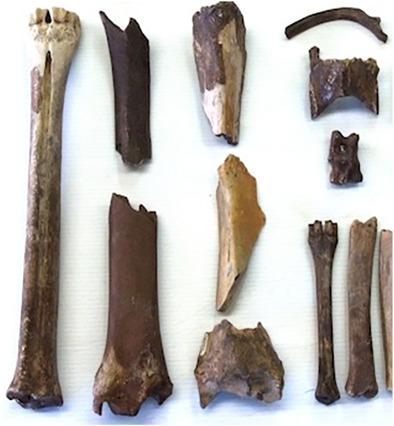当前位置:
X-MOL 学术
›
Magn. Reson. Chem.
›
论文详情
Our official English website, www.x-mol.net, welcomes your
feedback! (Note: you will need to create a separate account there.)
Input of solid-state 13 C NMR to study permeation of wet archaeological bones by dicarboxylic fatty diacid-based chemicals
Magnetic Resonance in Chemistry ( IF 1.9 ) Pub Date : 2020-03-13 , DOI: 10.1002/mrc.5015 Gilles Chaumat 1 , Florent Duval 1 , Rémi Blinder 2, 3 , Pierre-Alain Bayle 2 , Michel Bardet 2
Magnetic Resonance in Chemistry ( IF 1.9 ) Pub Date : 2020-03-13 , DOI: 10.1002/mrc.5015 Gilles Chaumat 1 , Florent Duval 1 , Rémi Blinder 2, 3 , Pierre-Alain Bayle 2 , Michel Bardet 2
Affiliation

|
Conservation treatment of degraded archaeological osseous materials is still an open challenge, since no specific conservation protocol is currently available for restorers or museum curators. This work aims to test the efficiency of two original consolidant solutions in consolidating archaeological material. Archaeological osseous materials remain rare and sparsely available, it is a real drawback for optimization of conservation treatments, therefore in the present work a set of representative samples was chosen. The consolidants tested were a solution of disodium sebacate and a novel polyalcohol (SG1.2) obtained by esterification of 5 succinic diacids with 6 molecules of glycerol at 150°C. Characterization studies of archaeological bones, combining SEM microscopy, IR spectroscopy and high-resolution solid-state 13 C NMR investigations, have been carried out to assess the effective permeation of bone by the consolidant solutions and to determine their chemical interactions with the residual components of archaeological bones. Although both water solutions significantly impregnate bone, we show that, the solution with disodium sebacate leads to chemical attack on the mineral component due to preferential precipitation of endogenous calcium by the sebacate ions. Such deleterious behaviour is not observed at all with the SG1,2 chemicals. The added value of the polyalcohol treatment as strengthening agent suitable for archaeological bony materials should be further demonstrated by mechanical and ageing tests.
中文翻译:

输入固态 13 C NMR 以研究基于二羧酸脂肪二酸的化学品对湿考古骨骼的渗透
退化的考古骨材料的保护处理仍然是一个公开的挑战,因为目前没有针对修复者或博物馆馆长的特定保护协议。这项工作旨在测试两种原始加固解决方案在加固考古材料方面的效率。考古骨材料仍然稀有且稀少,这是优化保护处理的真正缺点,因此在目前的工作中选择了一组具有代表性的样本。测试的固结剂是癸二酸二钠和一种新型多元醇 (SG1.2) 的溶液,通过 5 种琥珀酸与 6 分子甘油在 150°C 下酯化获得。考古骨骼的表征研究,结合 SEM 显微镜、红外光谱和高分辨率固态 13 C NMR 研究,已进行评估固结溶液对骨骼的有效渗透,并确定它们与考古骨骼残留成分的化学相互作用。尽管两种水溶液都能显着浸渍骨骼,但我们表明,由于癸二酸离子优先沉淀内源性钙,含有癸二酸二钠的溶液会导致对矿物成分的化学攻击。SG1,2 化学品完全没有观察到这种有害行为。多元醇处理作为适用于考古骨材料的强化剂的附加值应通过机械和老化试验进一步证明。
更新日期:2020-03-13
中文翻译:

输入固态 13 C NMR 以研究基于二羧酸脂肪二酸的化学品对湿考古骨骼的渗透
退化的考古骨材料的保护处理仍然是一个公开的挑战,因为目前没有针对修复者或博物馆馆长的特定保护协议。这项工作旨在测试两种原始加固解决方案在加固考古材料方面的效率。考古骨材料仍然稀有且稀少,这是优化保护处理的真正缺点,因此在目前的工作中选择了一组具有代表性的样本。测试的固结剂是癸二酸二钠和一种新型多元醇 (SG1.2) 的溶液,通过 5 种琥珀酸与 6 分子甘油在 150°C 下酯化获得。考古骨骼的表征研究,结合 SEM 显微镜、红外光谱和高分辨率固态 13 C NMR 研究,已进行评估固结溶液对骨骼的有效渗透,并确定它们与考古骨骼残留成分的化学相互作用。尽管两种水溶液都能显着浸渍骨骼,但我们表明,由于癸二酸离子优先沉淀内源性钙,含有癸二酸二钠的溶液会导致对矿物成分的化学攻击。SG1,2 化学品完全没有观察到这种有害行为。多元醇处理作为适用于考古骨材料的强化剂的附加值应通过机械和老化试验进一步证明。







































 京公网安备 11010802027423号
京公网安备 11010802027423号